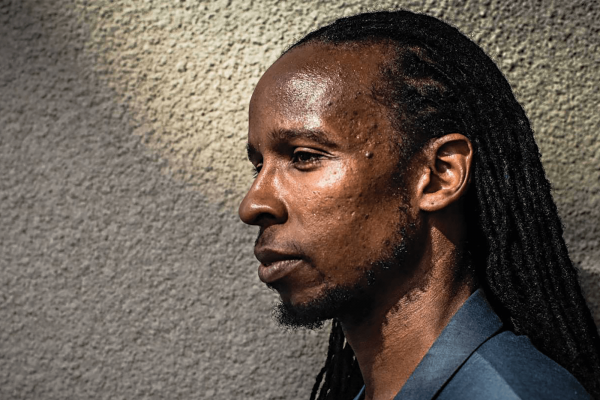SOMEWHERE IN AMERICA, surely there lies a graveyard filled with racist bones. It’s abandoned and dry as Ezekiel’s valley. No one is asking if these bones can live, least of all the many people who proclaim they don’t have a racist bone in their body. Better they turn to dust, lest they be DNA-tested and matched.
But Ibram X. Kendi is laying claim to his. Founding director of the Antiracist Research and Policy Center at American University in D.C. and award-winning author of Stamped from the Beginning: The Definitive History of Racist Ideas in America, Kendi identifies his own racist beliefs and actions in his latest book, How to Be an Antiracist, a deeply researched blend of history, sociology, law, and memoir.
“One of the central messages in How to Be an Antiracist is that we’re all on a personal journey to move away from our upbringing in a racist nation. And that journey must be deeply self-reflective and self-critical,” Kendi told me. “This is hard work. It’s easy to be racist. It’s extremely hard to be antiracist. But it’s possible, and I wanted to model how we could do that.” Kendi defines a racist as anyone (including a person of color like himself) “who is supporting a racist policy through their actions or inaction or expressing a racist idea.” Likewise, an antiracist is anyone “who is supporting an antiracist policy through their actions or expressing an antiracist idea.”
These descriptions “are not permanent tattoos,” Kendi writes, marking a person as racist for life, but rather like sticky name tags that can be placed and re-placed depending upon what a person is doing—or not doing. “It’s critical to become an active force in creating an equitable society, and to be a part of those forces that are challenging those policies that create inequity. And we all have a role to play.”
Kendi’s parents, Larry and Carol Rogers, were student activists who attended InterVarsity’s Urbana 70 Student Missions Conference nearly 50 years ago, drawn to the gathering by the band Soul Liberation and an evangelist named Tom Skinner. Skinner spoke of a Jesus who looked nothing like the white man in serene profile found on so many Sunday school classroom walls. Rather, as Kendi recounts in How to Be an Antiracist, Skinner said Jesus “was a radical revolutionary with hair on his chest and dirt under his fingernails,” and any true reading of the gospel must speak to issues of enslavement, justice, and inequality.
While black liberation theology kept his parents in the church, what Kendi calls “savior theology,” or using Christ to save “backward” people from their own misguided ways, drove him away. “This [belief] goes hand in hand with racist thought,” he said, “that the fundamental problem of societies is the inferiorities of people, and that is the reason why we have so many inequities.”
“Many millennials [like Ibram] have left the church because they see it accommodating systems in this world, rather than being prophetic and speaking out against them,” Carol Rogers told me. Kendi’s approach is focused on making policy changes—efforts that any church aiming to be antiracist could adopt.
“In that sort of church, following this revolutionary Jesus would be seeking to organize its people and resources to be a part of campaigns of change,” Kendi says.
But what about churches that object to organizing and advocating for policy change, calling these activities too political?
“I would respond that not engaging in campaigns of policy change is political, too,” Kendi said. “Just like a person who votes is doing a political act that decides an election, those who don’t vote engage in political acts that decide elections.”
Larry Rogers concurred: “When Jesus went against religious leaders of his day, wasn’t he being political?”
The chapter on activism in How to Be an Antiracist might discourage some readers. It’s titled “Failure.” But a person who writes “I arrived at Temple [University] as a racist, sexist, homophobe” isn’t looking to spare feelings. To Kendi, showing up at rallies and demonstrations is often about feeling less guilty. “Critiquing racism is not activism. Changing minds is not activism,” he writes. “What if we focused our human and fiscal resources on changing power and policy to actually make society, not just our feelings, better?”
Yet when Kendi spoke of what gives him hope, he mentioned the people who have shown up—movements against police brutality and sexual violence and harassment, and in support of gay rights. Likewise, although he might not classify changing minds as activism, he recognizes the importance of building relationships and trust to have difficult conversations around race and racism.
In a sense, Kendi is looking to take the sting out of the word “racist.”
“I do think [being racist] is bad, but I also think it is normal. That’s one of the messages I’ve tried to show in my work, to look at ourselves and say, ‘Yeah, I’m racist, and that’s quite normal, because of how our parents, our teachers, our media, our churches have taught us to be.’
“In other words, you weren’t born a racist. You have been trained and nurtured to be this way. And so therefore you have to turn a different corner.”

Got something to say about what you're reading? We value your feedback!






